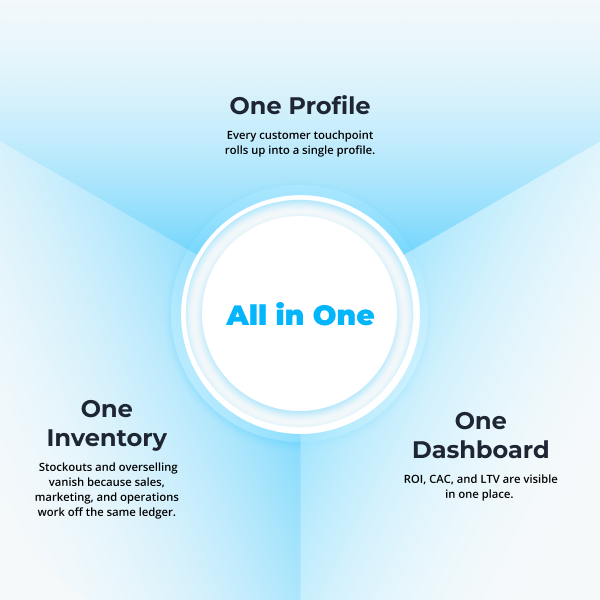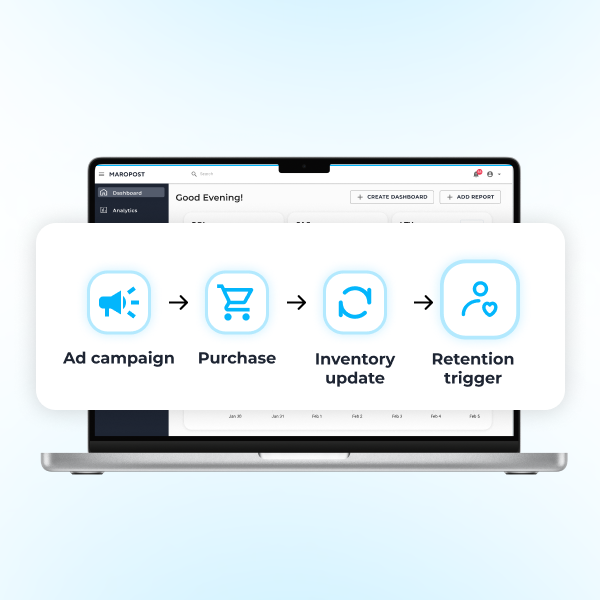Every e-commerce leader loves to brag about their “best-of-breed stack.” But if we’re honest? Most of those stacks look more like duct tape than digital transformation.
Behind the curtain, teams are drowning in connectors, API patches, and spreadsheets. Instead of speed and scale, they’re left with confusion and chaos.
Why fragmented stacks fail
Here’s the painful truth: scattered systems don’t scale.
🤔 Your CRM swears it knows your customer better than anyone.
📧 Your email platform’s got its own version of the truth.
🛒 POS? That’s just spinning a different tale altogether.
📦 And don’t even ask about inventory—half the time, it’s running on pure guesswork and good intentions.
That’s why abandoned carts, fulfillment delays, and ballooning CAC aren’t random acts of ecommerce misfortune. They’re the direct cost of running a Frankenstack.
The shift that changes everything
The fastest-growing brands have discovered something big: unification beats specialization.
They’ve stopped stacking tools for every problem and started consolidating into one system of record.
The payoff? Faster decisions, healthier margins, and customers who finally feel known.
The unified commerce flywheel
Think of unified commerce as a flywheel with three key pieces working together:
🧑💼 One Profile: Every touchpoint — online, offline, service, marketing — feeds into a single customer profile.
📦 One Inventory: No more stockouts or overselling. Everyone works off the same live ledger.
📊 One Dashboard: ROI, CAC, and LTV are visible in one place, not across a dozen tools.
When these three pieces lock in, growth compounds.
Good tools, wrong Setup
Let’s be clear: Shopify, Klaviyo, Salesforce — they’re all excellent tools. The issue isn’t the individual apps. It’s the fact they were never designed to deliver a single truth across marketing, commerce, and service.
So even the best point solutions end up creating silos when stitched together.
How unified commerce looks in real life
Here’s what this shift looks like inside an e-commerce business:
- Ad campaigns: Instead of guessing which channel drives revenue, you can tie ad spend directly to purchases, inventory movement, and repeat orders — in one dashboard.
- Checkout flow: Customers never hit the frustration of buying items that don’t exist. Real-time inventory cuts refunds and churn.
- Retention: Marketing teams trigger replenishment campaigns based on actual stock and behavior — not outdated exports.
This isn’t theory. It’s how unified commerce changes the daily workflow.
The risk of staying fragmented
Running “best-of-breed” isn’t just expensive — it’s risky.
- Every connector is a failure point.
- Every handoff creates lag.
- Every missed sync erodes customer trust.
How many times has your team spotted an integration failure only after revenue was lost?
Why it matters now
In e-commerce, customer experience is the margin.
When you can’t guarantee accurate inventory, personalized engagement, or reliable reporting, you’re not just leaking efficiency. You’re handing your customers to competitors who can.
And in a market this thin, that’s not a game you can afford to play.
How to get started
Here’s how operators can begin moving from scattered to unified:
- Audit your stack: Count how many tools it takes to run one campaign. You’ll see the inefficiencies immediately.
- Map the data flow: Spot where customer or inventory truth gets duplicated or delayed. That’s where trust breaks.
- Unify reporting: If proving ROI requires three logins, you don’t actually know your ROI.
- Test unification: Start with one brand or region. Proof of value beats theory every time.
The bottom line
Best-of-breed might have gotten you here. But unified commerce is what will get you there.
One profile. One inventory. One dashboard. One partner.
That’s how you stop stitching — and start scaling.
Book a demo of Maropost Unified Commerce today to see what clarity looks like.



